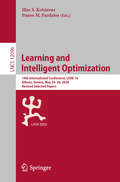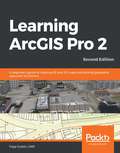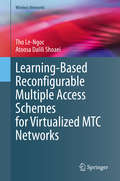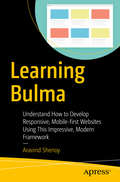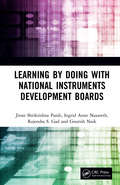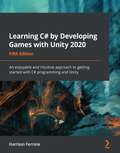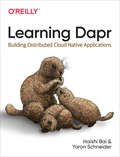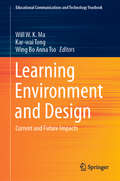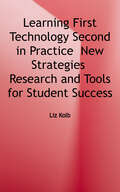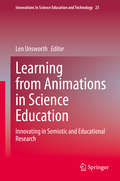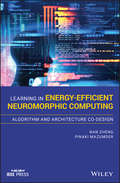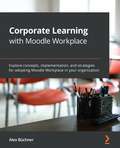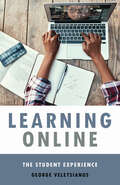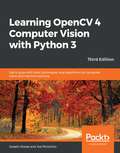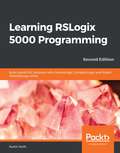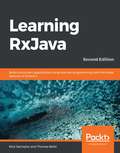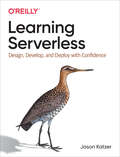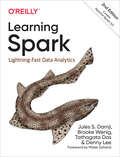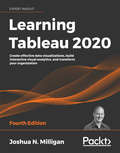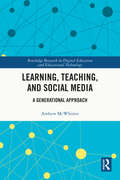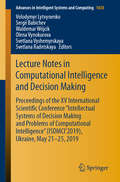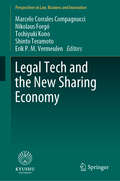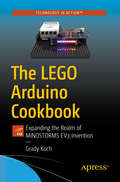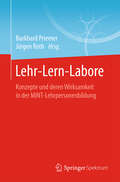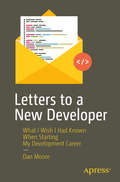- Table View
- List View
Learning and Intelligent Optimization: 14th International Conference, LION 14, Athens, Greece, May 24–28, 2020, Revised Selected Papers (Lecture Notes in Computer Science #12096)
by Ilias S. Kotsireas Panos M. PardalosThis book constitutes the refereed post-conference proceedings on Learning and Intelligent Optimization, LION 14, held in Athens, Greece, in May 2020. The 37 full papers presented together with one invited paper have been carefully reviewed and selected from 75 submissions. LION deals with designing and engineering ways of "learning" about the performance of different techniques, and ways of using past experience about the algorithm behavior to improve performance in the future. Intelligent learning schemes for mining the knowledge obtained online or offline can improve the algorithm design process and simplify the applications of high-performance optimization methods. Combinations of different algorithms can further improve the robustness and performance of the individual components. Due to the COVID-19 pandemic, LION 14 was not held as a physical meeting.
Learning ArcGIS Pro 2: A beginner's guide to creating 2D and 3D maps and editing geospatial data with ArcGIS Pro, 2nd Edition
by Tripp CorbinCreate 2D maps and 3D scenes, analyze GIS data, and share your results with the GIS community using the latest ArcGIS Pro 2 features Key Features Get up to speed with the new ribbon-based user interface, projects, models, and common workflows in ArcGIS Pro 2 Learn how to visualize, maintain, and analyze GIS data Automate analysis and processes with ModelBuilder and Python scripts Book Description Armed with powerful tools to visualize, maintain, and analyze data, ArcGIS Pro 2 is Esri's newest desktop geographic information system (GIS) application that uses the modern ribbon interface and a 64-bit processor to make using GIS faster and more efficient. This second edition of Learning ArcGIS Pro will show you how you can use this powerful desktop GIS application to create maps, perform spatial analysis, and maintain data. The book begins by showing you how to install ArcGIS and listing the software and hardware prerequisites. You'll then understand the concept of named user licensing and learn how to navigate the new ribbon interface to leverage the power of ArcGIS Pro for managing geospatial data. Once you've got to grips with the new interface, you'll build your first GIS project and understand how to use the different project resources available. The book shows you how to create 2D and 3D maps by adding layers and setting and managing the symbology and labeling. You'll also discover how to use the analysis tool to visualize geospatial data. In later chapters, you'll be introduced to Arcade, the new lightweight expression language for ArcGIS, and then advance to creating complex labels using Arcade expressions. Finally, you'll use Python scripts to automate and standardize tasks and models in ArcGIS Pro. By the end of this ArcGIS Pro book, you'll have developed the core skills needed for using ArcGIS Pro 2.x competently. What you will learn Navigate the user interface to create maps, perform analysis, and manage data Display data based on discrete attribute values or range of values Label features on a GIS map based on one or more attributes using Arcade Create map books using the map series functionality Share ArcGIS Pro maps, projects, and data with other GIS community members Explore the most used geoprocessing tools for performing spatial analysis Create Tasks based on common workflows to standardize processes Automate processes using ModelBuilder and Python scripts Who this book is for If you want to learn ArcGIS Pro to create maps and, edit and analyze geospatial data, this ArcGIS book is for you. No knowledge of GIS fundamentals or experience with any GIS tool or ArcGIS software suite is required. Basic Windows skills, such as navigating and file management, are all you need.
Learning-Based Reconfigurable Multiple Access Schemes for Virtualized MTC Networks (Wireless Networks)
by Tho Le-Ngoc Atoosa Dalili ShoaeiThis book assists readers with understanding the key aspects, problems and solutions related to the design of proper Multiple Access Schemes for MTC (Machine-Type Communications) and IoT applications in 5G-and-beyond wireless networks. An overview of MTC applications and their traffic features are also provided. In addition, it presents a comprehensive review of MTC access schemes including orthogonal multiple access schemes (OMA), non-orthogonal multiple access schemes (NOMA), massive MIMO-based schemes and fast uplink grant approaches. It also proposes efficient and reconfigurable access schemes deploying machine learning and optimization techniques to address the main requirements of MTC networks. This book discusses potential research directions to further enhance the performance of MTC access schemes.Machine-type communications are expected to account for the dominant share of the traffic in future wireless networks. While in traditional wireless networks, designed for human-type communications, the focus is on support of large packet sizes in downlink, machine-type communication systems deal with heavy uplink traffic. This is due to the nature of the tasks performed by machine-type communication devices, which is mainly reporting measured data or a detected event. Furthermore, in these networks, using the virtualization framework, the network infrastructure can be shared between different applications for which providing isolation is of high importance. To support these unique characteristics of machine-type communications, proper access schemes need to be developed, which is the focus of this book.This book benefits advanced-level students studying computer science and electrical engineering as a secondary textbook and researchers working in this field. Engineers and practitioners interested in the challenges and practical solutions of integrating MTC in the cloud radio access network of 5G-and-beyond cellular systems will want to purchase this book as well.
Learning Bulma: Understand How to Develop Responsive, Mobile-first Websites Using This Impressive, Modern Framework
by Aravind ShenoyLearn to use Bulma in your HTML file by applying easy-to-understand practical examples to create responsive and mobile-first websites.Featuring a step-by-step approach, this book encourages you to modify its code examples and review the changes produced in the output, to thereby reveal the subtle nuances of this awesome utility. Bulma is an impressive, modern framework utility that allows the easy construction of web pages thanks to the highly flexible Flex-box grid styles and simple syntax. You'll see how to use Bulma’s intuitive CSS capabilities to create interactive websites that support responsive design by dynamically adjusting the layout resulting in an optimal viewing experience. You'll then delve into typical modifiers, columns, Flex-box grid styles, forms, elements, utilities, CSS components, and more. By the end of this book, you will be familiar with the inner workings of Bulma at an intermediate level and be equipped to aptly leverage Bulma’s utilities to streamline your web designing experience. What You'll LearnGet started quickly with Bulma Use the grid system, layout, content, and modifiersLeverage Bulma’s built-in CSS utilitiesStreamline the web design experience with Bulma’s flexible attributesEffectively take a mobile-first approachWho This Book Is ForBeginners who have a basic understanding of HTML, CSS and JavaScript.
Learning by Doing with National Instruments Development Boards
by Jivan Shrikrishna Parab Ingrid Anne Nazareth Rajendra S. Gad Gourish NaikLearning by Doing with National Instruments Development Boards starts with a brief introduction to LabVIEW programming, which is required to explore the National Instrument platform, an introduction that includes detailed installation and licensing setup. Further, it gives the features and configuration setup of NI SPEEDY-33, NI ELVIS and myRIO boards. The focus of the book is on worked-out case studies for students working in different areas of electronics such as basic digital design, biomedical instrumentation, sensors and measurement. Data acquisition using SPEEDY-33, NI –ELVIS and myRIO kits is also odiscussed. The book also examines the myRIO platform.
Learning C# by Developing Games with Unity 2020 - Fifth Edition: An Enjoyable And Intuitive Approach To Getting Started With C# Programming And Unity
by Harrison FerroneIf you’re a developer, programmer, or anyone who wants to get started with C# programming in a fun and engaging manner, this book is for you. It’ll show you how to use the C# language and Unity to create games and scripts. Prior experience in programming or Unity is not required.
Learning Dapr
by Haishi Bai Yaron SchneiderGet the authoritative guide to Dapr, the distributed application runtime that works with new and existing programming languages alike. Written by the model’s creators, this introduction shows you how Dapr not only unifies stateless, stateful, and actor programming models but also runs everywhere—in the cloud or on the edge.Authors Haishi Bai and Yaron Schneider, both with Microsoft’s Azure CTO team, explain that, with Dapr, you don’t need to include any SDKs or libraries in your user code. Instead, you automatically get flexible binding, state management, the actor pattern, pub-sub, reliable messaging, and many more features. This book shows developers, architects, CIOs, students, and computing enthusiasts how to get started with Dapr.Learn the new programming model for cloud native applicationsWrite high-performance distributed applications without drilling into technical detailsUse Dapr with any language or framework to write microservices easilyLearn how Dapr provides consistency and portability through open APIs and extensible, community-driven componentsExplore how Dapr handles state, resource bindings, and pub-sub messaging to enable resilient event-driven architectures that scaleIntegrate cloud applications with various SaaS offerings, such as machine learning
Learning Environment and Design: Current and Future Impacts (Educational Communications and Technology Yearbook)
by Will W. K. Ma Kar-Wai Tong Wing Bo Anna TsoThis special edition of the Educational Communications and Technology Yearbook Series bears a title of “Learning Environment and Design: Current and Future Impact”. It provides a timely forum to share theoretical and practical insights in both the local and international contexts in response to the fact that new media and technologies have infiltrated and shaped the learning environments from mere physical spaces into multifaceted possibilities, impacting the ways individuals teach and learn. Designs of learning environments to harness technologies appropriately to engage learners better, as well as the roles of learners and educators play in this changing learning environment, are examples of important global issues in the discourse of the contemporary educational developments. Having gathered a diverse collection of research papers written by scholars and practitioners in the fields of education, communication and humanities across Asia, Australasia, Europe and the United States, this book gives readers a cross-cultural background on the developments of technological designs and educational practices, investigating areas in redefining of quality education; online learning and blended learning; new media in education; gamification, AI, and innovative learning technologies. Aimed to catalyze knowledge exchanges and provide fresh views on interdisciplinary research, the book sheds light on how emerging technologies can be adapted in the fields of education and communication, so as to facilitate the current and future designs of learning environments to improve learners’ performances.
Learning First, Technology Second in Practice: New Strategies, Research and Tools for Student Success
by Liz KolbBuilding on the bestselling Learning First, Technology Second, this book helps teachers choose technology tools and instructional strategies based on an understanding of how students learn. <p><p>After observing teachers and students interact with technology over many years, Liz Kolb began to wonder: While students' attention levels are high when they use digital devices, how can we move them to an equally high level of commitment to their learning tasks? Her extensive research into this question led to the development of the Triple E Framework, in which the learning goal—not the tool—is the most important element of a given lesson. <p><p>With this understanding, this book extends the ideas from Learning First, Technology Second, offering: <p><p>- An overview of the popular and highly regarded Triple E Framework. <p>- A compelling myth vs. reality format through which to apply the research and strategies tied to the Triple E Framework. <p>- A step-by-step process for instructional designers and tech coaches to use the framework with classroom teachers for better lesson design. <p>- Twelve authentic lessons designed by K-12 teachers to meet all three elements of the Triple E Framework, with suggestions on how to improve lessons with technology. <p>- Examples of how two schools have systematically integrated the framework across their district. <p><p>For Learning First, Technology Second readers, this book builds on their knowledge, providing new research, scenarios, cases and ideas for using technology in education. For readers new to the framework, this book provides all of the essential research and tools mentioned above, along with an overview of the framework, so they can apply what they learn without missing a beat.
Learning from Animations in Science Education: Innovating in Semiotic and Educational Research (Innovations in Science Education and Technology #25)
by Len UnsworthThis book examines educational semiotics and the representation of knowledge in school science. It discusses the strategic integration of animation in science education. It explores how learning through the creation of science animations takes place, as well as how animation can be used in assessing student’s science learning. Science education animations are ubiquitous in a variety of different online sites, including perhaps the most popularly accessed YouTube site, and are also routinely included as digital augmentations to science textbooks. They are popular with students and teachers and are a prominent feature of contemporary science teaching. The proliferation of various kinds of science animations and the ready accessibility of sophisticated resources for creating them have emphasized the importance of research into various areas: the nature of the semiotic construction of knowledge in the animation design, the development of critical interpretation of available animations, the strategic selection and use of animations to optimize student learning, student creation of science animations, and using animation in assessing student science learning. This book brings together new developments in these research agendas to further multidisciplinary perspectives on research to enhance the design and pedagogic use of animation in school science education. Chapter 1 is available open access under a Creative Commons Attribution 4.0 International License via link.springer.com.
Learning in Energy-Efficient Neuromorphic Computing: Algorithm And Architecture Co-design (Wiley - IEEE)
by Nan Zheng Pinaki MazumderExplains current co-design and co-optimization methodologies for building hardware neural networks and algorithms for machine learning applications This book focuses on how to build energy-efficient hardware for neural networks with learning capabilities—and provides co-design and co-optimization methodologies for building hardware neural networks that can learn. Presenting a complete picture from high-level algorithm to low-level implementation details, Learning in Energy-Efficient Neuromorphic Computing: Algorithm and Architecture Co-Design also covers many fundamentals and essentials in neural networks (e.g., deep learning), as well as hardware implementation of neural networks. The book begins with an overview of neural networks. It then discusses algorithms for utilizing and training rate-based artificial neural networks. Next comes an introduction to various options for executing neural networks, ranging from general-purpose processors to specialized hardware, from digital accelerator to analog accelerator. A design example on building energy-efficient accelerator for adaptive dynamic programming with neural networks is also presented. An examination of fundamental concepts and popular learning algorithms for spiking neural networks follows that, along with a look at the hardware for spiking neural networks. Then comes a chapter offering readers three design examples (two of which are based on conventional CMOS, and one on emerging nanotechnology) to implement the learning algorithm found in the previous chapter. The book concludes with an outlook on the future of neural network hardware. Includes cross-layer survey of hardware accelerators for neuromorphic algorithms Covers the co-design of architecture and algorithms with emerging devices for much-improved computing efficiency Focuses on the co-design of algorithms and hardware, which is especially critical for using emerging devices, such as traditional memristors or diffusive memristors, for neuromorphic computing Learning in Energy-Efficient Neuromorphic Computing: Algorithm and Architecture Co-Design is an ideal resource for researchers, scientists, software engineers, and hardware engineers dealing with the ever-increasing requirement on power consumption and response time. It is also excellent for teaching and training undergraduate and graduate students about the latest generation neural networks with powerful learning capabilities.
Learning Moodle Workplace
by Alex BüchnerThis book is for workplace administrators in technical, organizational as well as pedagogical capacity. Managers who lead teams in the workplace, especially HR, will also find it useful. Learners who use Workplace for their continuous professional development will also benefit from the book. Prior exposure to the Moodle platform will help you follow the book easily.
Learning Online: The Student Experience (Tech.edu: A Hopkins Series on Education and Technology)
by George VeletsianosWhat's it really like to learn online?Learning Online: The Student ExperienceOnline learning is ubiquitous for millions of students worldwide, yet our understanding of student experiences in online learning settings is limited. The geographic distance that separates faculty from students in an online environment is its signature feature, but it is also one that risks widening the gulf between teachers and learners. In Learning Online, George Veletsianos argues that in order to critique, understand, and improve online learning, we must examine it through the lens of student experience.Approaching the topic with stories that elicit empathy, compassion, and care, Veletsianos relays the diverse day-to-day experiences of online learners. Each in-depth chapter follows a single learner's experience while focusing on an important or noteworthy aspect of online learning, tackling everything from demographics, attrition, motivation, and loneliness to cheating, openness, flexibility, social media, and digital divides. Veletsianos also draws on these case studies to offer recommendations for the future and lessons learned. The elusive nature of online learners' experiences, the book reveals, is a problem because it prevents us from doing better: from designing more effective online courses, from making evidence-informed decisions about online education, and from coming to our work with the full sense of empathy that our students deserve. Writing in an evocative, accessible, and concise manner, Veletsianos concretely demonstrates why it is so important to pay closer attention to the stories of students—who may have instructive and insightful ideas about the future of education.
Learning OpenCV 4 Computer Vision with Python 3: Get to grips with tools, techniques, and algorithms for computer vision and machine learning, 3rd Edition
by Joseph Howse Joe MinichinoUpdated for OpenCV 4 and Python 3, this book covers the latest on depth cameras, 3D tracking, augmented reality, and deep neural networks, helping you solve real-world computer vision problems with practical code Key Features Build powerful computer vision applications in concise code with OpenCV 4 and Python 3 Learn the fundamental concepts of image processing, object classification, and 2D and 3D tracking Train, use, and understand machine learning models such as Support Vector Machines (SVMs) and neural networks Book Description Computer vision is a rapidly evolving science, encompassing diverse applications and techniques. This book will not only help those who are getting started with computer vision but also experts in the domain. You'll be able to put theory into practice by building apps with OpenCV 4 and Python 3. You'll start by understanding OpenCV 4 and how to set it up with Python 3 on various platforms. Next, you'll learn how to perform basic operations such as reading, writing, manipulating, and displaying still images, videos, and camera feeds. From taking you through image processing, video analysis, and depth estimation and segmentation, to helping you gain practice by building a GUI app, this book ensures you'll have opportunities for hands-on activities. Next, you'll tackle two popular challenges: face detection and face recognition. You'll also learn about object classification and machine learning concepts, which will enable you to create and use object detectors and classifiers, and even track objects in movies or video camera feed. Later, you'll develop your skills in 3D tracking and augmented reality. Finally, you'll cover ANNs and DNNs, learning how to develop apps for recognizing handwritten digits and classifying a person's gender and age. By the end of this book, you'll have the skills you need to execute real-world computer vision projects. What you will learn Install and familiarize yourself with OpenCV 4's Python 3 bindings Understand image processing and video analysis basics Use a depth camera to distinguish foreground and background regions Detect and identify objects, and track their motion in videos Train and use your own models to match images and classify objects Detect and recognize faces, and classify their gender and age Build an augmented reality application to track an image in 3D Work with machine learning models, including SVMs, artificial neural networks (ANNs), and deep neural networks (DNNs) Who this book is for If you are interested in learning computer vision, machine learning, and OpenCV in the context of practical real-world applications, then this book is for you. This OpenCV book will also be useful for anyone getting started with computer vision as well as experts who want to stay up-to-date with OpenCV 4 and Python 3. Although no prior knowledge of image processing, computer vision or machine learning is required, familiarity with basic Python programming is a must.
Learning RSLogix 5000 Programming: Build robust PLC solutions with ControlLogix, CompactLogix, and Studio 5000/RSLogix 5000, 2nd Edition
by Austin ScottGet to grips with the Logix platform, Rockwell Automation terminologies, and the online resources available in the Literature Library Key Features Build real-world solutions using ControlLogix, CompactLogix, and RSLogix 5000/Studio 5000 Understand the different controllers and form factors offered by the ControlLogix and CompactLogix platforms Explore the latest changes in the Studio 5000 Automation Engineering and Design software suite Book Description Understanding programmable logic controller (PLC) programming with Rockwell Software's Logix Designer and the Studio 5000 platform, which includes ControlLogix, CompactLogix, and SoftLogix, is key to building robust PLC solutions. RSLogix 5000/Studio 5000's Logix Designer are user-friendly IEC 61131-3-compliant interfaces for programming the current generation of Rockwell Automation Controllers using Ladder Diagram (LD), Function Block Diagram (FBD), Structured Text (ST), and Sequential Function Chart (SFC). This second edition of Learning RSLogix 5000 Programming guides you through the technicalities and comes packed with the latest features of Studio 5000, industrial networking fundamentals, and industrial cybersecurity best practices. You'll go through the essential hardware and software components of Logix, before learning all about the new L8 processor model and the latest Studio 5000 architecture to build effective integrated solutions. Entirely new for this edition, you'll discover a chapter on cybersecurity concepts with RSLogix 5000. The book even gets you hands-on with building a robot bartender control system from start to finish. By the end of this Logix 5000 book, you'll have a clear understanding of the capabilities of the Logix platform and be able to confidently navigate Rockwell Automation Literature Library resources. What you will learn Gain insights into Rockwell Automation and the evolution of the Logix platform Find out the key platform changes in Studio 5000 and Logix Designer Explore a variety of ControlLogix and CompactLogix controllers Understand the Rockwell Automation industrial networking fundamentals Implement cybersecurity best practices using Rockwell Automation technologies Discover the key considerations for engineering a Rockwell Automation solution Who this book is for If you're a PLC programmer, an electrician, an instrumentation technician, or an automation professional with basic PLC programming knowledge, but no knowledge of RSLogix 5000, this RSLogix 5000 book is for you. You'll also find the book useful if you're already familiar with automation and want to learn about RSLogix 5000 software in a short time span.
Learning RxJava: Build concurrent applications using reactive programming with the latest features of RxJava 3, 2nd Edition
by Thomas Nield Nick SamoylovUpdated with the latest Maven coordinates, Java programming features, and API changes, this book is your guide to solving problems in writing asynchronous and event-based programs Key Features Explore a variety of tools and techniques used to solve problems in implementing concurrency and parallelization Learn about core operators in RxJava that enable you to express your code logic productively Apply RxJava with Kotlin to create responsive Android apps with better user experience Book Description RxJava is not just a popular library for building asynchronous and event-based applications; it also enables you to create a cleaner and more readable code base. In this book, you'll cover the core fundamentals of reactive programming and learn how to design and implement reactive libraries and applications. Learning RxJava will help you understand how reactive programming works and guide you in writing your first example in reactive code. You'll get to grips with the workings of Observable and Subscriber, and see how they are used in different contexts using real-world use cases. The book will also take you through multicasting and caching to help prevent redundant work with multiple Observers. You'll then learn how to create your own RxJava operators by reusing reactive logic. As you advance, you'll explore effective tools and libraries to test and debug RxJava code. Finally, you'll delve into RxAndroid extensions and use Kotlin features to streamline your Android apps. By the end of this book, you'll become proficient in writing reactive code in Java and Kotlin to build concurrent applications, including Android applications. What you will learn Discover different ways to create Observables, Observers, and Subscribers Multicast in order to push data to multiple destinations and cache and replay them Express RxJava idiomatically with the help of Kotlin features such as extension functions and data classes Become familiar with various operators available in RxJava to perform common transformations and tasks Explore RxJava's reactive types, including Flowable, Single, Maybe, and Completable Demystify Observables and how they express data and events as sequences Who this book is for This book is for Java developers who want to leverage reactive programming to develop more resilient and concurrent applications. If you're an RxJava user looking to get to grips with the latest features and updates in RxJava 3, this book is for you. Fundamental knowledge of core Java features and object-oriented programming will assist you in understanding the key concepts covered in this book.
Learning Serverless: Design, Develop, And Deploy With Confidence
by Jason KatzerWhether your company is considering serverless computing or has already made the decision to adopt this model, this practical book is for you. Author Jason Katzer shows early- and mid-career developers what's required to build and ship maintainable and scalable services using this model. <P><P>With this book, you'll learn how to build a modern production system in the cloud, viewed through the lens of serverless computing. You'll discover how serverless can free you from the tedious task of setting up and maintaining systems in production. You'll also explore new ways to level up your career and design, develop, and deploy with confidence. <P><P>In three parts, this book includes:The Path to Production: Examine the ins and outs of distributed systems, microservices, interfaces, and serverless architecture and patternsThe Tools: Dive into monitoring, observability and alerting, logging, pipelines, automation, and deploymentConcepts: Learn how to design security and privacy, how to manage quality through testing and staging, and how to plan for failure
Learning Spark: Lightning-Fast Data Analytics
by Denny Lee Jules S. Damji Brooke Wenig Tathagata DasData is bigger, arrives faster, and comes in a variety of formats—and it all needs to be processed at scale for analytics or machine learning. But how can you process such varied workloads efficiently? Enter Apache Spark.Updated to include Spark 3.0, this second edition shows data engineers and data scientists why structure and unification in Spark matters. Specifically, this book explains how to perform simple and complex data analytics and employ machine learning algorithms. Through step-by-step walk-throughs, code snippets, and notebooks, you’ll be able to:Learn Python, SQL, Scala, or Java high-level Structured APIsUnderstand Spark operations and SQL EngineInspect, tune, and debug Spark operations with Spark configurations and Spark UIConnect to data sources: JSON, Parquet, CSV, Avro, ORC, Hive, S3, or KafkaPerform analytics on batch and streaming data using Structured StreamingBuild reliable data pipelines with open source Delta Lake and SparkDevelop machine learning pipelines with MLlib and productionize models using MLflow
Learning Tableau 2020: Create effective data visualizations, build interactive visual analytics, and transform your organization, 4th Edition
by Joshua N. MilliganGain a solid foundation to learn Tableau, and develop the skills and abilities required for an advanced mastery of the tool. Whether you're new to Tableau or have been using it years, you will benefit from this book. Key Features Explore the latest Tableau 2020 features and redefine business analytics for your firm Understand visualizing data and creating interactive dashboards to gain meaningful insights Learn implementing effective data storytelling to redefine how your business leverages data and makes decisions Book Description Learning Tableau strengthens your command on Tableau fundamentals and builds on advanced topics. The book starts by taking you through foundational principles of Tableau. We then demonstrate various types of connections and how to work with metadata. We teach you to use a wide variety of visualizations to analyze and communicate the data, and introduce you to calculations and parameters. We then take an in-depth look at level of detail (LOD) expressions and use them to solve complex data challenges. Up next, we show table calculations, how to extend and alter default visualizations, build an interactive dashboard, and master the art of telling stories with data. This Tableau book will introduce you to visual statistical analytics capabilities, create different types of visualizations and dynamic dashboards for rich user experiences. We then move on to maps and geospatial visualization, and the new Data Model capabilities introduced in Tableau 2020.2. You will further use Tableau Prep's ability to clean and structure data and share the stories contained in your data. By the end of this book, you will be proficient in implementing the powerful features of Tableau 2020 for decision-making. What you will learn Develop stunning visualizations to explain complex data with clarity Explore exciting new Data Model capabilities Connect to various data sources to bring all your data together Leverage Tableau Prep Builder's amazing capabilities for data cleaning and structuring Create and use calculations to solve problems and enrich the analytics Master advanced topics such as sets, LOD calculations, and much more Enable smart decisions with data clustering, distribution, and forecasting Share your data stories to build a culture of trust and action Who this book is for This Tableau book is for anyone who wants to understand data. If you're new to Tableau, don't worry. This book will simplify Tableau for beginners to build on the foundations to help you understand how Tableau really works and then builds on that knowledge with practical examples before moving on to advanced techniques. Having a bit of background with data will help, but you don't need to know scripting, SQL or database structures.
Learning, Teaching, and Social Media: A Generational Approach (Routledge Research in Digital Education and Educational Technology)
by Andrew McWhirterEmploying a unique generational approach, this book critically assesses social media in educational contexts across all educational levels: from primary and secondary schools to further and higher education, proposing a schema for social media literacy (SML). Using research obtained from fieldwork observations conducted in online teaching groups, surveys, and in-depth interviews with teachers and educators on the topic of social media and education, chapters interrogate the historical relationship between educator and learner, and use the frame of expert methodology to understand what educators themselves consider important about social media and education relative to their sectors. Bringing together current literature from education, learning and media technologies, along with longstanding debates around technological influence, chapters also draw on audience and communication studies, psychology and arts and humanities at a time when many different disciplines are trying to understand what social media means to our society. This interdisciplinary volume will be of great interest to academics, researchers and postgraduates in the fields of technology in education, media literacy, and critical digital media. Practitioners involved in the sociology of education will also find the book of use.
Lecture Notes in Computational Intelligence and Decision Making: Proceedings of the XV International Scientific Conference “Intellectual Systems of Decision Making and Problems of Computational Intelligence” (ISDMCI'2019), Ukraine, May 21–25, 2019 (Advances in Intelligent Systems and Computing #1020)
by Volodymyr Lytvynenko Sergii Babichev Waldemar Wójcik Olena Vynokurova Svetlana Vyshemyrskaya Svetlana RadetskayaInformation and computer technologies for data analysis and processing in various fields of data mining and machine learning generates the conditions for increasing the effectiveness of information processing by making it faster and more accurate. The book includes 49 scientific papers presenting the latest research in the fields of data mining, machine learning and decision-making. Divided into three sections: “Analysis and Modeling of Complex Systems and Processes”; “Theoretical and Applied Aspects of Decision-Making Systems”; and “Computational Intelligence and Inductive Modeling”, the book is of interest to scientists and developers in the field.
Legal Tech and the New Sharing Economy (Perspectives in Law, Business and Innovation)
by Toshiyuki Kono Nikolaus Forgó Marcelo Corrales Compagnucci Shinto Teramoto Erik P. M. VermeulenThe exponential growth of disruptive technology is changing our world. The development of cloud computing, big data, the internet of things, artificial intelligence, machine learning, deep learning, and other related autonomous systems, such as self-driving vehicles, have triggered the emergence of new products and services. These significant technological breakthroughs have opened the door to new economic models such as the sharing and platform-based economy. As a result, companies are becoming increasingly data- and algorithm-driven, coming to be more like “decentralized platforms”. New transaction or payment methods such as Bitcoin and Ethereum, based on trust-building systems using Blockchain, smart contracts, and other distributed ledger technology, also constitute an essential part of this new economic model. The sharing economy and digital platforms also include the everyday exchange of goods allowing individuals to commodify their surplus resources. Information and innovation technologies are used in order to then match these resources with existing demand in the market. Online platforms such as Airbnb, Uber, and Amazon reduce information asymmetry, increase the value of unused resources, and create new opportunities for collaboration and innovation. Moreover, the sharing economy is playing a major role in the transition from exclusive ownership of personal assets toward access-based exploitation of resources. The success of online matching platforms depends not only on the reduction of search costs but also on the trustworthiness of platform operators. From a legal perspective, the uncertainties triggered by the emergence of a new digital reality are particularly urgent. How should these tendencies be reflected in legal systems in each jurisdiction? This book collects a series of contributions by leading scholars in the newly emerging fields of sharing economy and Legal Tech. The aim of the book is to enrich legal debates on the social, economic, and political meaning of these cutting-edge technologies. The chapters presented in this edition attempt to answer some of these lingering questions from the perspective of diverse legal backgrounds.
The LEGO Arduino Cookbook: Expanding the Realm of MINDSTORMS EV3 Invention
by Grady KochPush into new fields of technology using LEGO and Arduino with the projects in this Cookbook. MINDSTORMS EV3 inventions don’t have to be confined to LEGO factory-made sensors. Incorporate a wide range of sensors, displays, LED arrays, actuators, and even a smartphone into your creations. Add amazing capabilities to your LEGOs by building things such as a metal detector, long-range lidar, audio spectrum analyzer, weather station, and a smartphone. Step-by-step instructions bring these new devices to life. You’ll work with the reliable and inexpensive Arduino UNO to take your projects even further and make them truly smart. Learn to set up and program your Arduino UNO. Then learn data communications protocols (I2C, SPI, and PWM) to link sensors to the Arduino. A variety of data communications techniques are also demonstrated on passing data between the Arduino and the MINDSTORMS EV3 Intelligent Brick. Equipped with these new tools, LEGO inventors can build vast new capabilities into their designs. What You'll LearnInterface new sensors, devices, and communications with LEGO Mindstorms EV3Work with communication protocols of pulse width modulation (PWM), I2c, and SPIConvert pulse width modulation to analog voltage with resistor and capacitor componentsWho This Book Is ForTech savvy fans of LEGO projects and hardware hackers. Also coaches or students involved in a school science/technology project or design competition.
Lehr-Lern-Labore: Konzepte und deren Wirksamkeit in der MINT-Lehrpersonenbildung
by Burkhard Priemer Jürgen RothAn verschiedenen Hochschulen werden in den MINT-Fächern Schülerlabore in die Lehrpersonenbildung integriert. In diesen - als Lehr-Lern-Labore bezeichneten - Einrichtungen werden MINT-Lernumgebungen für Schülerinnen und Schüler, Veranstaltungen der Lehrpersonenbildung und an vielen Standorten auch fachdidaktische Forschung fruchtbar miteinander verknüpft. Das Ziel ist dabei, evidenzbasiert innovative Lehrkonzepte für Schule und Hochschule zu entwickeln und zu implementieren. In diesem Band werden Lehr-Lern-Labore zunächst allgemein beschrieben und dann durch zahlreiche Beispiele von Konzepten verschiedener Hochschulstandorte illustriert. Darüber hinaus wird berichtet, welche Wirksamkeit Lehr-Lern-Labore bei der Förderung von Kompetenzen zukünftiger Lehrpersonen haben und wie Studierende diese Einrichtungen wahrnehmen. Die vorgestellten Forschungsergebnisse, die aus einem Verbund von sechs Hochschulen stammen, sollen durch diesen Band weiteren Standorten zugänglich gemacht werden. Dieses Buch richtet sich an Studierende und Dozierende der Lehrpersonenbildung in Hochschulen - insbesondere in den MINT-Fachdidaktiken - sowie an Personen in Schule und Referendariat.
Letters to a New Developer: What I Wish I Had Known When Starting My Development Career
by Dan MooreLearn what you need to succeed as a developer beyond the code. The lessons in this book will supercharge your career by sharing lessons and mistakes from real developers. Wouldn’t it be nice to learn from others’ career mistakes? “Soft” skills are crucial to success, but are haphazardly picked up on the job or, worse, never learned. Understanding these competencies and how to improve them will make you a more effective team member and a more attractive hire.This book will teach you the key skills you need, including how to ask questions, how and when to use common tools, and how to interact with other team members. Each will be presented in context and from multiple perspectives so you’ll be able to integrate them and apply them to your own career quickly.What You'll LearnKnow when the best code is no codeUnderstand what to do in the first month of your jobSee the surprising number of developers who can’t programAvoid the pitfalls of working aloneWho This Book Is For Anyone who is curious about software development as a career choice. You have zero to five years of software development experience and want to learn non-technical skills that can help your career. It is also suitable for teachers and mentors who want to provide guidance to their students and/or mentees.
